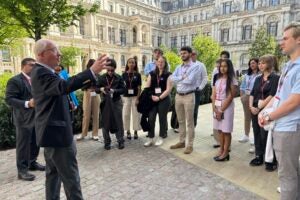AUSTIN, Texas—An end to speculation about the brain size of the famous fossil animal, Archaeopteryx lithographica, is in sight as scientists scan the braincase of this bird-dinosaur intermediate.
|
||
|
Photo: Marsha Miller
|
||
|
Angela Milner (left), paleontologist for the Natural History Museum, London, places the 147 million-year-old archaeopteryx skull fragment into the CT scanner in Dr. Tim Rowe’s lab. The highly sensitive scanner can distinguish rock from bone in a fossil and show a detailed reconstuction of the inside of the brain case. This data will contain clues about the whether this specimen is more dinosaur-like or bird-like.
|
The work is being done in the university’s state-of-the-art, high-resolution X-ray computed tomographic (X-ray CT) scanner by staff and scientists of the Digital Morphology Group. They are producing a three-dimensional reproduction suitable for virtual dissection.
The university’s facility is considered by experts to be the only one of its kind in the world capable of completing the project.
“This is the only Archaeopteryx found with the brain case still intact,” said Dr. Tim Rowe, co-director of the CT scanner facility. “Dissecting this specimen would be out of the question. It would be destroyed.”
The CT scanner allows the original specimen to remain intact, Rowe said.
“The scanner takes 1,300 two-dimensional X-ray pictures, then ‘prints’ a three-dimensional replica that is the exact configuration of the original,” he said. “For this particular printing, we’ve reproduced the specimen four times its actual size to facilitate study of it. ”
Discovered in 1861, the specimen, which is about 147 million years old, shows the two lobes of the brain, and other parts of the head.
“Some scientists speculate that the brain of Archaeopteryx was about as well developed as modern birds, but there is actually little information about its brain case,” Rowe said. “These scans, when studied, will provide the data needed to resolve the controversy.”
|
||
|
Photo: Marsha Miller
|
||
|
The skull fragment of archaeopteryx, an intermediate form between dinosaurs and birds, is one of the most important pieces in the Natural History Museum, London.
|
This one-of-a-kind specimen was brought to the university from London, hand-carried by Dr. Angela Milner, associate keeper of paleontology at the Natural History Museum, and Professor John Cookson, an imaging scientist and visiting professor at the University of Hartfordshire.
“The University of Texas at Austin’s CT scanner is the only facility set up and geared for this kind of work in the world,” said Milner. “Other facilities had neither the power, nor expertise, nor experience.”
Cookson agrees. “The facility has the right mix of components and staff — expert people. Of all the places we’ve tried to get this done, the university’s Digital Morphology Group had the right combination of computer and biological knowledge.”
About the size of a modern-day grackle, Archaeopteryx was a meat-eating dinosaur that is considered by many to be the first bird. It is an intermediate between modern-day birds and predatory dinosaurs such as Deinonychus.
Its feathers, wings and small fingers are all characteristics of modern birds. Unlike modern-day birds, however, Archaeopteryx had a full set of teeth, a rather flat sternum, a long, bony tail, ribs across the belly and three claws on the wing which that have been used to grasp.
It is thought that Archaeopteryx could sustain powered flight, but it probably was not a strong flier, relying mostly on its ability to run, leap and glide.
Images of Archaeopteryx will be studied by Milner, Cookson and Rowe for about one year before they become publicly available. Other images (e.g., interactive Web movies of various dinosaurs, an alligator skull, a horned lizard skeleton and an intact egg of the extinct elephant bird of Madagascar) can be viewed at the Digimorph Web site.
The Digital Morphology project is a production of the CT facility, the Department of Geological Sciences, The Center for Instructional Technologies and The Texas Memorial Museum of Science and History. It has received major grant support from the National Science Foundation. The CT facility is housed in the Department of Geological Sciences.
For further information contact: Susan Romberg and Edward Theriot, Texas Memorial Museum of Science and History, 512-232-5654.





